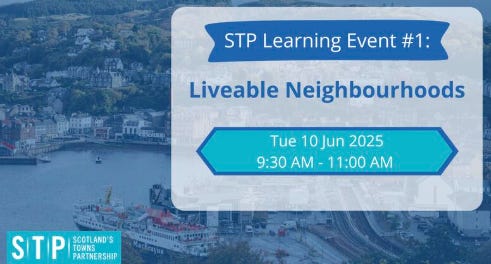Places Briefing #7
Socially inclusive cities, Placed-based policy-making, Proximity Planning, Walking and Cycling, Remote working and cities, liveable neighbourhoods
Here is a further collection of short notes on recent publication, reports and a webinar series which seem to offer insights into important issues for the development of places, and add background to topics picked up in pieces on Policies for Places. If you have time to delve deeper, there is a wealth of case studies, policy ideas and research in the reports referenced or on their publishers’ websites.
Socially inclusive cities
In recent decades, Nordic cities have witnessed a general trend towards increased urban segregation, which has led to a wide range of policy and planning interventions addressing these issues across the Nordic countries. This very accessible report examines how Nordic governments and cities address challenges of urban segregation through various policies, strategies, and plans that seek to foster greater social inclusion.
The report takes a multi-case study approach from 13 cities across 5 Nordic countries. It focusses on 4 main themes:
- The policy landscape for policies aimed at countering segregation and promoting inclusion:
- Public participation and citizen involvement policies;
- The role of architecture and design; and
- The role of Indicators and data.
This is an excellent analysis and reflection on the Nordic experience from Nordregio, a well respected international research organization on regional development and planning. Incidentally they have an excellent website showing the range of topics they have studied.
Place-based Policy Making
This new report from OECD makes the case for intelligent localization to unlock the latent potential in cities and regions in future decades. The report argues that spatially-blind policies are counterproductive and that local context must become central and not peripheral to policy design.
To help address future challenges, this report synthesizes the latest knowledge and evidence on place-based policies based on 12 expert papers commissioned by the OECD and the European Commission. It highlights the need for effective place-based policies that support structural transformations to build the long term economic, social and environmental sustainability of regions—and consequently of countries.
Walking and cycling
The World Health Organization (WHO) has just published a new toolkit for promoting walking and cycling.
The toolkit presents policy options for walking and cycling, highlighting the multiple benefits that promoting and enabling safe walking and cycling for recreation and transport can bring to individuals, communities, the environment, and the economy. It outlines strategic policy options for countries to consider implementing to enable safer walking and cycling for people of all ages and abilities, and to support maintaining or increasing levels of walking and cycling either for transport or active recreation . It includes to case studies of how these policy options are being successfully put into practice.
Proximity Planning
I referenced this study in a recent piece on Policies for Places. It reveals a significant gap between theoretical proximity and actual behavior in Barcelona's implementation of the 15-minute city concept.
Despite excellent proximity metrics (95% of residents have access to daily needs within a 15-minute walk), only 26% actually practice a 15-minute lifestyle, with sociodemographic factors proving more influential than built environment.
Key findings include:
* Women, older adults (65+), and those with primary education are more likely to adopt proximity-based lifestyles
* Men, younger adults (16-29), and university graduates tend to travel beyond nearby options
* People often prioritize variety, specialized experiences, and dispersed social networks over proximity
* Established travel habits and car-dependent culture create barriers even in highly accessible neighborhoods
The research demonstrates that physical proximity alone cannot transform mobility patterns and suggests a range of planning strategies incorporating behavioral insights to complement proximity planning approaches.
The challenge of hybrid working for cities
This report from ISPI the Italian Institute for International Political Studies explores how remote working has impacted cities and citizens, from mobility to urban planning. A series of papers examine examine a range of topics about how remote working can reshape global cities, the strategies which are available to city authorities in the face of changes in work-life balance, demand for transportation, skills and the labor market and others. It explores if remote working is still the future?
Liveable neighbourhoods
Here is an up-coming webinar series from the Scottish Towns Partnership which will examine a range of issues relating to neighbourhood development. This event brings together placemaking leaders, local authorities and regeneration experts, with case studies, policy insights and space for open discussion.
Full details of the webinar and sign up are here.
ooOoo
I hope you find this selection interesting. If you would like other topics to be featured, please let me know.
Here are some other recent posts from Policies for Places which you might have missed.
‘Nearness’ and social cohesion









